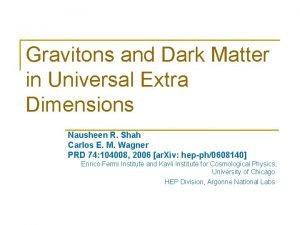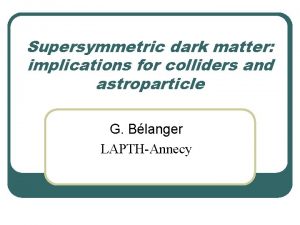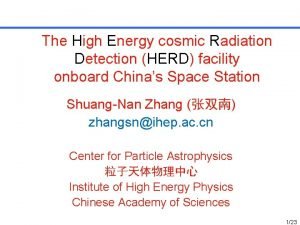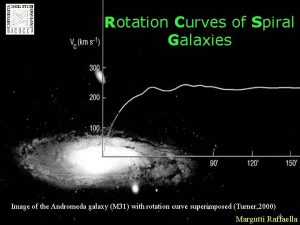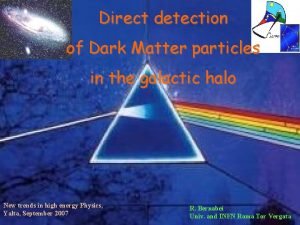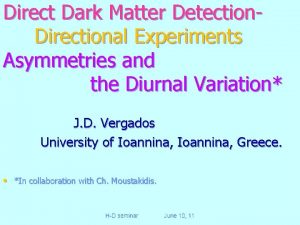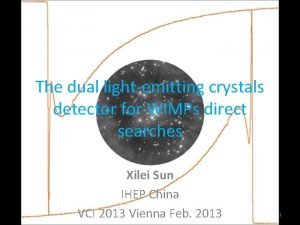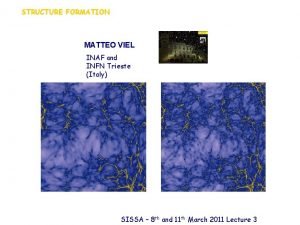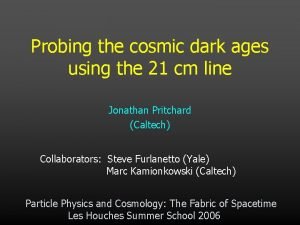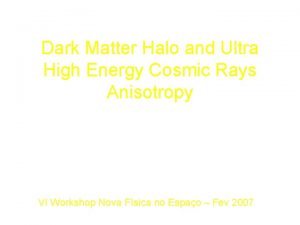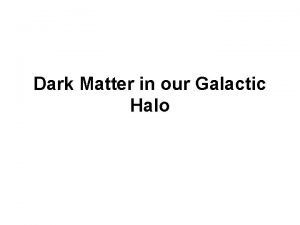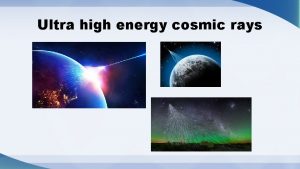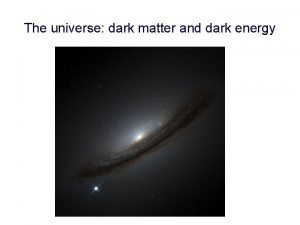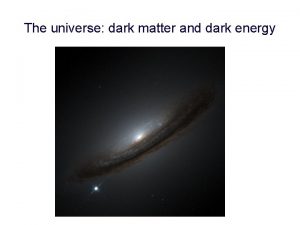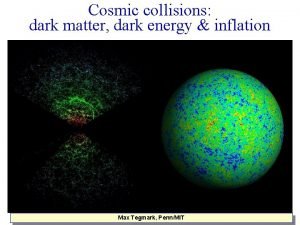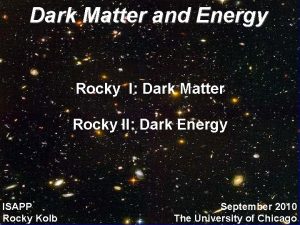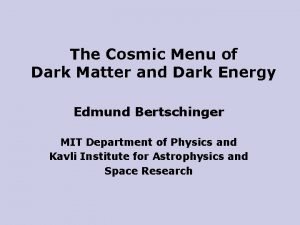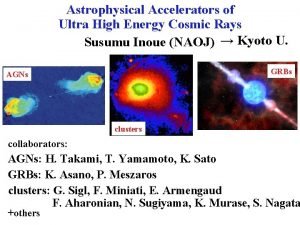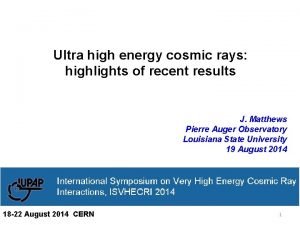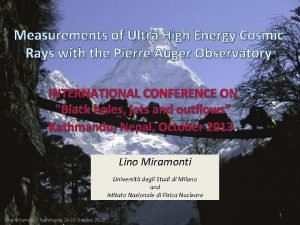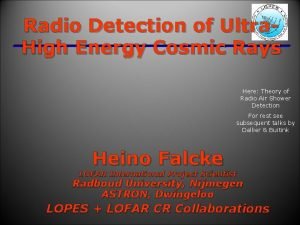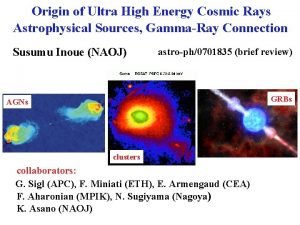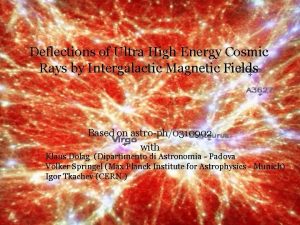Dark Matter Halo and Ultra High Energy Cosmic



















- Slides: 19

Dark Matter Halo and Ultra High Energy Cosmic Rays Anisotropy Beatriz B. Siffert – UFRJ Angela V. Olinto – University of Chicago João R. T. de Mello Neto - UFRJ VI Workshop Nova Física no Espaço – Fev 2007

I. Introduction Acceleration of UHECR is still an open question. Two classes of models: ● Bottom-Up: acceleration through astrophysical objects or environments (compact objects, shock waves, etc). ● Top-Down: cosmic ray originate from the decay or annihilation of heavy relics from the early universe. Dark matter particles in the halo of our galaxy and nearby galaxies could be a source for UHECR observed on the Earth.

In this scenario the strongest contributions would come from our own galaxy and from the Andromeda galaxy (M 31). I estimate the anisotropy patterns in the arrival directions map that would be observed by the Pierre Auger experiment (South+North) if UHECR originate from the decay and annihilation of dark matter particles in the halo of the Milky Way and of M 31. Only the relative contributions of the 2 galaxies were estimated, not the real flux value.

II. Density Profiles of Dark Matter in the Halos Distribution of dark matter particles throughout the halo as a function of the distance to the center of the galaxy, r. Different profiles are obtained from numerical simulations of structure formation with Cold Dark Matter (CDM). r Sun Dark Matter Element

I used the profiles proposed by Navarro, Frenk and White* (NFW) and by Moore et al. **: 0 → dark matter density in the sun's position. a → characteristic length R 0 → distance from the Earth to the center of the galaxy. NFW: = 1, = 3, = 1 Moore et al. : = 1. 5, = 3, = 1. 5 * Astrophysical Journal v. 462, p. 563 (1996) ** Mon. Not. R. Astron. Soc. 310, 1147 -1152 (1999)

III. Flux Estimation Since the Earth is not at the center of the Galaxy, we should expect an anisotropic cosmic ray flux due to our galaxy's halo.

Flux in a direction that forms an angle with the line that connects the Earth to the GC: 2 ρ→ρ annihilation K → depends on model adopted for the dark matter's particle. Supposing the same density profile for the Galaxy and for M 31, the flux due to M 31* is: z~ 2 is mass of M 31's halo/mass MW’s halo, D is distance to M 31. *G. A. Medina Tanco, A. A. Watson, Astropaticle Physics 12 (1999) 25 -34

Events measured by Auger are subjected to its exposure. It gives the detection probability as a function of the declination of the arrival direction of the cosmic ray. Auger South All maps shown take into account Auger's exposure.

Theoretical Exposure of Auger South+North: cos(δ) Paul Sommers, Astropart. Phys. 14 (2001) 271 -286

Map that would be observed by Auger (south+north) if the cosmic ray flux were isotropic: Galactic coordinates

Decay Relative flux of MW and M 31 for NFW density profile. M 31 Relative flux of MW and M 31 for Moore et al. density profile. Contribution from M 31 is insignificant.

Annihilation NFW The contribution of our galaxy is very small. Moore et al. Flux is larger but still much smaller than in the decay case.

IV. Adding an isotropic background Total contribution of DM is a fraction η of the background. Φ TOTAL = Φ DM + Φ ISOT Φ DM = Φ ISOT (0< <1) To account for anisotropies we evaluate the dipole and quadrupole terms of the expansion of the flux:

C 1 Dipole Term - Decay

C 1 Dipole Term - Annihilation Dipole term for decay scenario ~ 103 times larger. NFW compatible with isotropy.

Quadrupole Term - Decay

Quadrupole Term - Annihilation Same conclusion about Decay X Annihilation. Contribution of M 31 didn’t change any of the results.

V. Conclusion The contribution of M 31 is insignificant compared to the contribution of our galaxy. The flux predicted from the decay model is much stronger than the one predicted from the annihilation model. Dipole shape dominates. VI. Improvements Evaluate the actual flux value to compare with real data. More realistic density profile?

We can do astronomy with the high energy events. They point back to their sources.
 Ptasie radio brzozow
Ptasie radio brzozow Dark matter and dark energy presentation
Dark matter and dark energy presentation Flow energy review
Flow energy review In a dark dark town
In a dark dark town Acn home phone
Acn home phone Matter gravitons dimensions
Matter gravitons dimensions Boosted dark matter
Boosted dark matter Dark matter
Dark matter Calo
Calo Dark matter physics
Dark matter physics Where to stream dark matter
Where to stream dark matter What could dark matter be
What could dark matter be Dark matter
Dark matter Dark matter
Dark matter Dark matter
Dark matter Les houches dark matter
Les houches dark matter Gray and white matter
Gray and white matter Gray matter and white matter
Gray matter and white matter Gray matter and white matter
Gray matter and white matter What does grey matter do
What does grey matter do





